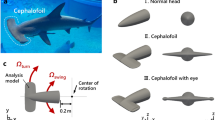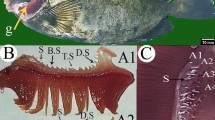Abstract
The lateral line system is a mechanosensory organ found in all fish species and located on the skin or in subdermal canals. The basic functional units are superficial and canal neuromasts, which are involved in hydrodynamic sensing and cohesion in schooling fish. Yellow-eyed mullet (Aldrichetta forsteri) are an obligate schooling species found commonly in shallow coastal areas of New Zealand and Australia. Schooling is a fundamental part of their behavioural repertoire, yet little is known about the structure or functionality of the lateral line in this species. We used scanning electron microscopy to characterise the morphology of trunk superficial neuromasts. We then took a multi-sensory approach and conducted behavioural experiments comparing school structure in groups of fish with and without fully functioning lateral lines, under photopic and scotopic conditions. A highly developed hydro-sensing system exists on the trunk of yellow-eyed mullet consisting of superficial neuromasts containing hundreds of hair cells aligned, with respect to their most sensitive axis, in a rostrocaudal direction. Without functioning superficial neuromasts, schooling behaviour was disrupted under both photopic and scotopic conditions and the ability to detect stationary objects decreased. Results highlight the importance of this component of the lateral line system to schooling behaviour.







Similar content being viewed by others
Abbreviations
- 2D:
-
Two-dimensional
- 3D:
-
Three-dimensional
- BL:
-
Body length
- CN:
-
Canal neuromast
- LLS:
-
Lateral line system
- NND:
-
Nearest neighbour distance
- SA:
-
Separation angle
- SEM:
-
Scanning electron microscopy
- SN:
-
Superficial neuromast
References
Appelbaum S, Schemmel C (1983) Dermal sense organs and their role in the feeding behaviour of the common sole, Solea vulgaris. Mar Ecol Prog Ser 13:29–36
Azuma T, Iwata M (1994) Influences of illumination intensity on the nearest neighbour distance in coho salmon Oncorhynchus kisutch. J Fish Biol 45(6):1113–1118
Blaxter J (1987) Structure and development of the lateral line. Biol Rev 62(4):471–514
Bleckmann H, Zelick R (2009) Lateral line system of fish. Integr Zool 4(1):13–25. doi:10.1111/j.1749-4877.2008.00131.x
Burgess JW, Shaw E (1981) Effects of acoustico-lateralis denervation in a facultative schooling fish: a nearest-neighbor matrix analysis. Behav Neural Biol 33(4):488–497
Cahn PH (1972) Sensory factors in the side-to-side spacing and positional orientation of the tuna, Euthynnus affinis, during schooling. Fish Bull 70(1):197–204
Coombs S, Janssen J, Webb JF (1988) Diversity of lateral line systems: evolutionary and functional considerations. In: Atema J, Fay RR, Popper AN, Tavolga W (eds) Sensory biology of aquatic animals. Springer, Berlin, pp 553–593
Dijkgraaf S (1962) The functioning and significance of the lateral-line organs. Biol Rev 38(1):51–105
Engelmann J, Hanke W, Mogdans J, Bleckmann H (2000) Neurobiology: hydrodynamic stimuli and the fish lateral line. Nature 408(6808):51–52. doi:10.1038/35040706
Faucher K, Parmentier E, Becco C, Vandewalle N, Vandewalle P (2010) Fish lateral system is required for accurate control of shoaling behaviour. Anim Behav 79(3):679–687. doi:10.1016/j.anbehav.2009.12.020
Fischer EK, Soares D, Archer KR, Ghalambor CK, Hoke KL (2013) Genetically and environmentally mediated divergence in lateral line morphology in the Trinidadian guppy (Poecilia reticulata). J Exp Biol 216(16):3132–3142. doi:10.1242/jeb.081349
Flock A, Wersall J (1962) A study of the orientation of the sensory hairs of the receptor cells in the lateral line organ of fish, with special reference to the function of the receptors. J Cell Biol 15(1):19–27
Gardiner JM, Atema J, Hueter RE, Motta PJ (2014) Multisensory integration and behavioral plasticity in sharks from different ecological niches. PloS One 9(4):e93036. doi:10.1371/journal.pone.0093036
Gray J, Denton E (1991) Fast pressure pulses and communication between fish. J Mar Biol Assoc UK 71(01):83–106
Ishida Y, Asaoka R, Nakae M, Sasaki K (2015) The trunk lateral line system and its innervation in Mugil cephalus (Mugilidae: Mugiliformes). Ichthyol Res 62(3):253–257. doi:10.1007/s10228-014-0433-8
Kasumyan A (2003) The lateral line in fish: structure, function, and role in behavior. J Ichthyol 43(2):175–213
Klein A, Münz H, Bleckmann H (2013) The functional significance of lateral line canal morphology on the trunk of the marine teleost Xiphister atropurpureus (Stichaeidae). J Comp Physiol A 199(9):735–749. doi:10.1007/s00359-013-0834-6
Larsson M (2009) Possible functions of the octavolateralis system in fish schooling. Fish Fish 10(3):344–353. doi:10.1111/j.1467-2979.2009.00330.x
Larsson M (2012) Why do fish school? Curr Zool 58(1):116–128
Liu C-H, Shen S-C (1991) Lepidology of the Mugilid fishes. J Taiwan Mus 44(2):321–357
Liu C-H, Shen S-C (1993) The lateral-line canal system in Mugilid fishes (Perciformes: Mugilidae). Acta Zool Taiwan 4(1):21–31
Lum AM, Wassersug RJ, Potel MJ, Lerner SA (1982) Schooling behavior of tadpoles: a potential indicator of ototoxicity. Pharmacol Biochem Behav 17(2):363–366
Montgomery JC, Carton AG (2008) The senses of fish: chemosensory, visual and octavolateralis. In: Magnhagen C, Braithwaite V, Forsgren E, Kapoor BG (eds) Fish behaviour. Science Publishers, New Hampshire, pp 3–31
Montgomery J, Bleckmann H, Coombs S (2014) Sensory ecology and neuroethology of the lateral line. In: Coombs S, Bleckmann H, Fay RR, Popper AN (eds) The lateral line system. Springer, Berlin, pp 121–150. doi:10.1007/2506_2013_17
Mussen TD, Cech JJ Jr (2013) The roles of vision and the lateral-line system in Sacramento splittail’s fish-screen avoidance behaviors: evaluating vibrating screens as potential fish deterrents. Environ Biol Fishes 96(8):971–980. doi:10.1007/s10641-012-0094-2
New JG, Fewkes LA, Khan AN (2001) Strike feeding behavior in the muskellunge, Esox masquinongy: contributions of the lateral line and visual sensory systems. J Exp Biol 204(6):1207–1221
Partridge BL (1981) Lateral line function and the internal dynamics of fish schools. In: Tavolga W, Popper AN, Fay RR (eds) Hearing and sound communication in fishes. Springer, New York, pp 515–522
Partridge BL, Pitcher TJ (1980) The sensory basis of fish schools: relative roles of lateral line and vision. J Comp Physiol 135(4):315–325
Pitcher TJ, Partridge BL, Wardle CS (1976) A blind fish can school. Science 194(4268):963–965
Schmitz A, Bleckmann H, Mogdans J (2014) The lateral line receptor array of cyprinids from different habitats. J Morphol 275(4):357–370. doi:10.1002/jmor.20219
SeaGIS (2017) EventMeasure SeaGIS Pty. Bacchus Marsh, Australia www.seagis.com
Shaw E (1978) Schooling fishes. Am Sci 66(2):166–175
Song J (1981) Chinese mugilid fishes and morphology of their cephalic lateral-line canals. Sinozoologia 1:9–22
van Netten SM, McHenry MJ (2013) The biophysics of the fish lateral Line. In: Coombs S, Bleckmann H, Fay RR, Popper AN (eds) The lateral line system. Springer, New York, pp 99–119. doi:10.1007/2506_2013_14
Van Trump WJ, Coombs S, Duncan K, McHenry MJ (2010) Gentamicin is ototoxic to all hair cells in the fish lateral line system. Hear Res 261(1–2):42–50. doi:10.1016/j.heares.2010.01.001
Von Campenhausen C, Riess I, Weissert R (1981) Detection of stationary objects by the blind cave fish Anoptichthys jordani (Characidae). J Comp Physiol 143(3):369–374
Webb J (2011) Lateral line structure. In: Farrell AP (ed) Encyclopedia of fish physiology: from genome to environment, vol 1. Academic Press, San Diego, pp 336–346
Wellenreuther M, Brock M, Montgomery J, Clements KD (2010) Comparative morphology of the mechanosensory lateral line system in a clade of New Zealand triplefin fishes. Brain Behav Evol 75(4):292–308. doi:10.1159/000317061
Windsor SP, Norris SE, Cameron SM, Mallinson GD, Montgomery JC (2010) The flow fields involved in hydrodynamic imaging by blind Mexican cave fish (Astyanax fasciatus). Part I: open water and heading towards a wall. J Exp Biol 213(22):3819–3831. doi:10.1242/jeb.040741
Yanase K, Herbert NA, Montgomery JC (2014) Unilateral ablation of trunk superficial neuromasts increases directional instability during steady swimming in the yellowtail kingfish Seriola lalandi. J Fish Biol 85(3):838–856. doi:10.1111/jfb.12476
Acknowledgements
We thank the New Zealand Institute for Plant and Food Research Limited for the provision of facilities and animals used in this research, which forms part of the requirements for a doctoral degree, and was supported through their Seafood Production Units Wildfish 2030 Ministry for Business, Innovation and Employment funded programme (Contract # C11X1203). Thanks also to Manfred Inglefeld for assistance with microscopy, Dr. Kerry Swanson, Mike Flaws and Jan MacKenzie for assisting in the preparation of SEM samples, Dr. Peter Jaksons for statistical advice, and David Ashton for developing Python code. We also thank the anonymous reviewers for their time and acknowledge that their comments have helped improve earlier versions of this manuscript.
Author information
Authors and Affiliations
Corresponding authors
Ethics declarations
Conflict of interest
The authors declare that they have no conflict of interest.
Ethical statement
All experiments were conducted in accordance with the University of Canterbury Animal Ethics Committee (Ref: 2015/02R). Methods were carried out in accordance with approved guidelines.
Rights and permissions
About this article
Cite this article
Middlemiss, K.L., Cook, D.G., Jerrett, A.R. et al. Morphology and hydro-sensory role of superficial neuromasts in schooling behaviour of yellow-eyed mullet (Aldrichetta forsteri). J Comp Physiol A 203, 807–817 (2017). https://doi.org/10.1007/s00359-017-1192-6
Received:
Revised:
Accepted:
Published:
Issue Date:
DOI: https://doi.org/10.1007/s00359-017-1192-6




